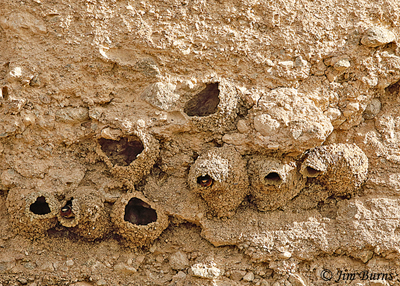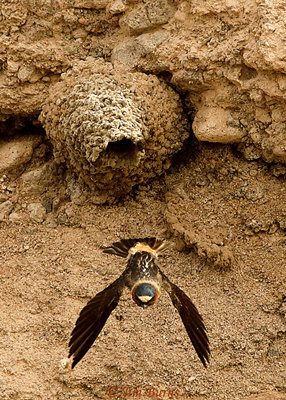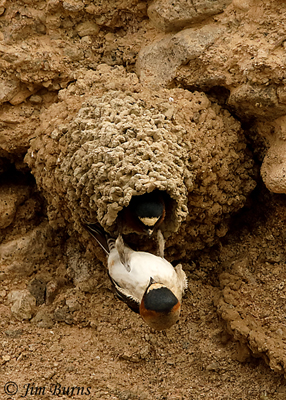
Cliff Swallows are familiar, by sight, to all of us, and we marvel at their “engineering” skills in building mud nests on vertical faces, both natural ones on cliffs and man-made ones on bridges and over/underpasses. But loitering and observing with the camera led me to research and learn that some of my preconceived ideas about the species were erroneous. I began to see Cliff Swallows rather than just looking at them.
We know they are colonial nesters, and this colony with which I’m most familiar must have, already in these early days of the species return from the south, upwards to 200 nests. In focusing on just one individual nest in an attempt to catch one of the pair actually flying in or out of its retort shaped home, I realized after two birds had left that a third swallow appeared at the opening. Uh oh!
I had assumed upon their return in the spring that the swallows paired up, constructed their mud home, raised their young, and lived happily ever after. After also noticing swallows flying from one nest to another I knew I had to dig into the swallow literature. Here’s what Birds of North America has to say—“The Cliff Swallow’s highly colonial life style has led to the evolution of some complex behavioral traits. For instance, Cliff Swallows brood-parasitize neighboring nests both by laying parasitic eggs and by moving eggs from their own nest into others.”
In other words Cliff Swallows, much like another species we all know all too well, don’t have family trees so much as family bushes. There are other aspects of their unique coloniality unrealized by casual birders: a complex system of vocalizations allow parents to find their own young within the colony; they use thermals and convection currents to locate insect swarms; colonies often appear to leave en masse for periods of time simply because they observe neighbors’ success returning with insect prey and follow one another to locate the source; wing fluttering observed when a whole colony converges on a mud source is suspected to prevent extra-pair copulation.
Cliff Swallow was one of the first North American birds described to science. It is one of our most studied birds as well as one of our most common. It is a species with legendary status because it returns to Mission San Juan Capistrano on precisely March 19 every year which has engendered a community parade and celebration. This latter fact is known to birders and non-birders alike. The exquisite evolutionary adaptations to its unique lifestyle, not so much. Just another reason for birders to do a little research from time to time rather than just tick a list and hurry to the next sighting.
Cliff Swallow leaving nest--9694 |
Cliff Swallows at home--9763 |

